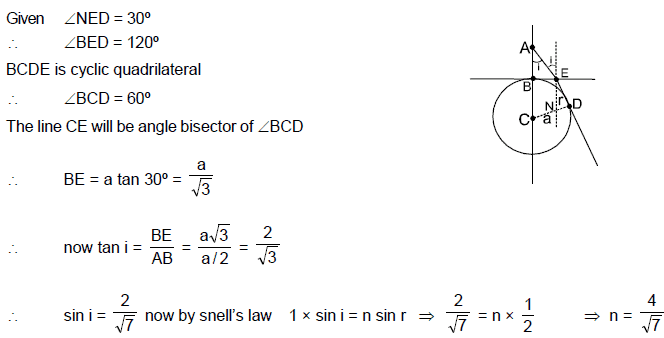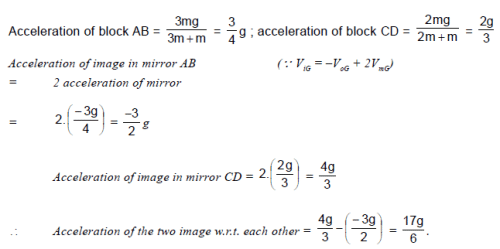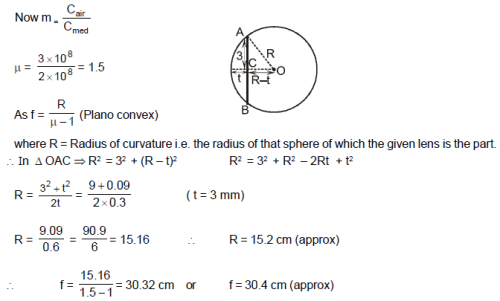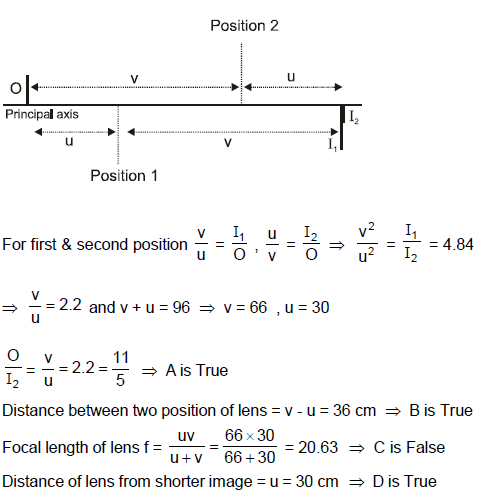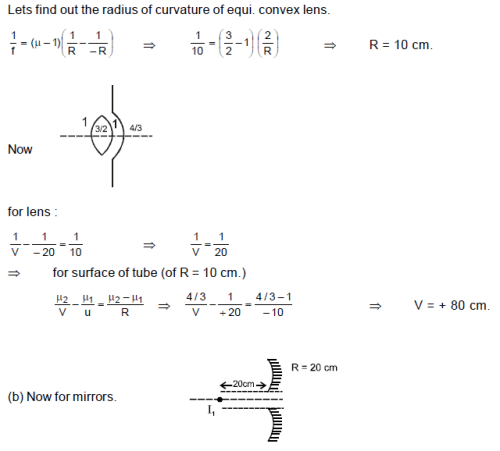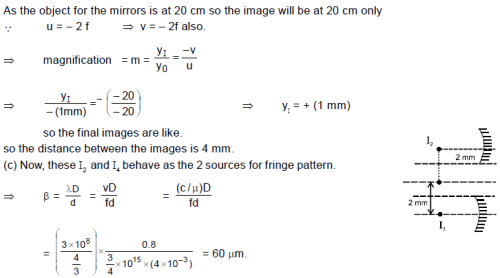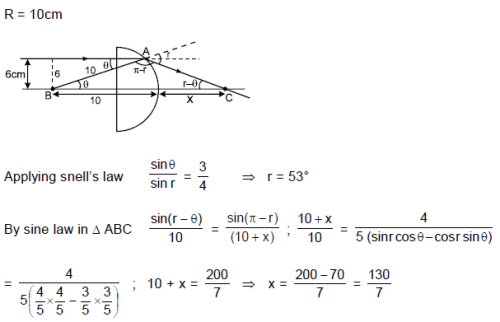JEE Advanced Test- 4 - JEE MCQ
30 Questions MCQ Test Mock Tests for JEE Main and Advanced 2025 - JEE Advanced Test- 4
An opaque sphere of radius a is just immersed in a transparent liquid as shown in figure. A point source is placed on the vertical diameter of the sphere at a distance a/2 from the top of the sphere. One ray originating from the point source after refraction from the air liquid interface forms tangent to the sphere. The angle of refraction for that particular ray is 30º. The refractive index of the liquid is
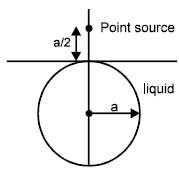

A thin oil film of refractive index 1.2 floats on the surface of water (m = 4/3) When a light of wavelength l = 9.6 × 10–7 m falls normally on the film from air, then it appears dark when seen normally. The minimum change in its thickness for which it will appear bright in normally reflected light by the same light is:
| 1 Crore+ students have signed up on EduRev. Have you? Download the App |
In a YDSE experiment if a slab whose refractive index can be varied is placed in front of one of the slits then the variation of resultant intensity at mid-point of screen with 'µ' will be best represented by (µ ³ 1).[ Assume slits of equal width and there is no absorption by slab; mid point of screen is the point where waves interfere with zero phase difference in absence of slab]
Two blocks each of mass m lie on a smooth table. They are attached to two other masses as shown in the figure. The pulleys and strings are light. An object O is kept at rest on the table. The sides AB & CD of the two blocks are made reflecting. The acceleration of two images
formed in those two reflecting surfaces w.r.t. each other is:
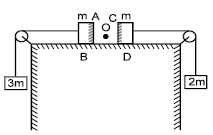
A ray is incident on the first prism at an angle of incidence 53º as shown in the figure. The angle between side CA and B'A' for the net deviation by both the prisms to be double of the deviation produced by the first prism, will be :
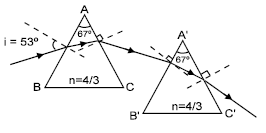
Light of wavelength 4000 Å is incident at small angle on a prism of apex angle 4º. The prism has nv = 1.5 & nr = 1.48. The angle of dispersion produced by the prism in this light is :
Two plane mirrors are joined together as shown in figure. Two point objects O1 and O2 are placed symmetrically such that AO1 = AO2. The image of the two objects is common if :

Monochromatic light rays parallel to x-axis strike a convex lens AB. If the lens oscillates such that AB tilts upto a small angle q (in radian) on either side of y-axis, then the amplitude of oscillation of image will be (f = focal length of the lens) :
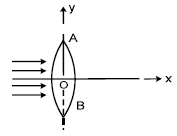
A particle is moving towards a fixed convex mirror. The image also moves. If Vi = speed of image and VO = speed of the object, then
The speed of light in the material of a plano convex lens is 2 × 108 m/s and its greatest thickness is 3 mm. If the aperture diameter of the lens in 6.0 cm then :
In displacement method, the distance between object and screen is 96 cm. The ratio of length of two images formed by a convex lens placed between them is 4.84.
Which of the following statements is/are correct about the refraction of light from a plane surface when light ray is incident in denser medium. [C is critical angle]
Statement-1 : A beam of white light enters the curved surface of a semicircular piece of glass along the normal. The incoming beam is moved clockwise (so that the angle q increases), such that the beam always enters along the normal to the curved side. Just before the refracted beam disappears, it becomes predominantly red.
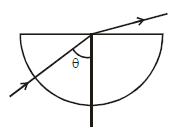
Statement-2 : The index of refraction for light at the red end of the visible spectrum is more than at the violet end
Statement-1 : A point object moves near the principal axis of a fixed spherical mirror along a straight line. Then the image formed by the spherical mirror also moves along a straight line.
Statement-2 : For an incident ray on a fixed spherical mirror there is a fixed reflected ray. If a point object moves along this incident ray, its image will always lie on the given reflected ray. Further an incident ray may be drawn from the moving point object in its direction of velocity towards the mirror.
Paragraph for Question Nos. 15
A monochromatic point source S of wavelength l = 5000√2 Å (in air) is placed at a distance d = 1 mm below the surface of transparent liquid as shown in figure. A very large screen is placed along y-axis at horizontal distance D = 1 metre from point source. The refractive index of liquid is √2 . ( Neglect partial reflection of rays from source S at liquid-air interface.)
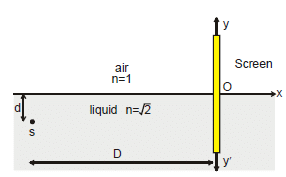
Q. The y-coordinates of second order bright formed on the screen is
Paragraph for Question Nos. 15
A monochromatic point source S of wavelength l = 5000 √2 Å (in air) is placed at a distance d = 1 mm below the surface of transparent liquid as shown in figure. A very large screen is placed along y-axis at horizontal distance D = 1 metre from point source. The refractive index of liquid is√2 . ( Neglect partial reflection of rays from source S at liquid-air interface.)

Q. The region on screen where interference pattern is formed lies in
Paragraph for Question Nos. 15
A monochromatic point source S of wavelength l = 5000√2 Å (in air) is placed at a distance d = 1 mm below the surface of transparent liquid as shown in figure. A very large screen is placed along y-axis at horizontal distance D = 1 metre from point source. The refractive index of liquid is√2 . ( Neglect partial reflection of rays from source S at liquid-air interface.)

Q. The minimum horizontal distance of screen from fixed source such that at least one bright is formed on screen
Matrix - Match Type
A white light ray is incident on a glass prism, and it create four refracted rays A, B, C and D. Match the refracted rays with the colours given (1 & D are rays due to total internal reflection.):
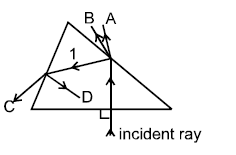
Ray Colour
(A) A (p) red
(B) B (q) green
(C) C (r) yellow
(D) D (s) blue
An equiconvex lens of focal length 10 cm (in air) and R.I 3/2 is put at a small opening on a tube of length 1 m fully filled with liquid of R.I. 4/3. A concave mirror of radius of curvature 20 cm is cut into two halves m1 and m2 and placed at the end of the tube. m1 & m2 are placed such that their principal axes AB and CD respectively are separated by 1 mm each from the principal axes of the lens. A slit S placed in air illuminates the lens with light of frequency 7.5 ´ 1014 Hz. The light reflected from m1 and m2 forms interference pattern on the left end EFof the tube. O is an opaque substance to cover the gap left by m1 & m2.
The position of the image formed by lens water combination is a × 10-2m from lens and the distance between the images formed by m1 & m2 is b × 10-3 m then find ab/40.
.
In the figure shown light of wave length l = 5000 Å is incident on the slits (in a horizontal fixed plane) S1 and
S2 separated by distance d = 1 mm. A horizontal screen ‘S’ is released from rest from initial distance
D0 = 1 m from the plane of the slits. Taking origin at O and positive x and y axis as shown, at t = 2 seconds;
(Use g = 10 m/s2) velocity is 10n j ˆ and acceleration is m j ˆ of central maxima, find the value of [mm/25].
A is a thin walled sphere at rest made up of glass. The radius of the sphere is 1m and it is filled with a
transparent liquid of refractive index m. S is the luminous source moving directly towards a plane
vertical mirror M. A fish in the liquid is moving towards S. The eye of the fish and S are collinear &
perpendicular to mirror M. At the moment S is 3m away from the centre of the sphere, fish observes
that image of S due to reflection is moving with speed of 13m/s. If speed of the fish relative to the
sphere is 10m/s and m = 1.5 then find the speed of the source at that instant. The system is placed
in air.
A light ray parallel to the principal axis is incident (as shown in the figure) on a thin planoconvex lens
with radius of curvature of its curved part equal to 10 cm. Assuming that the refractive index of the
material of the lens is 4/3 and medium on both sides of the lens is air, find the distance of the point from
the lens where this ray meets the principal axis. Find your answer in the form X/7 cm and fill value
of X.
On vigorous oxidation of (CH3)2C=CH—CH2 —CH3 by permanganate solution gives :
|
357 docs|148 tests
|
|
357 docs|148 tests
|


